Beef Soup Bone Steak Can You Eat as a Steak
Steak is one of the most popular types of food on the planet. The different types of steak actually refer to the cuts of beef from the cow. The tenderest cuts of beef come from the middle of the animal where there is less muscle. The levels of fat in the beef cut affect the flavor and nutritional profile of each type of steak.
Although there is much discussion on the health implications of eating too much red meat, steak varieties are packed with nutrients.
In this article, you will learn about the most popular types of steak and how to cook them. You will also find out about the nutritional value of these different beef cuts. At the end of the article, you will learn how to pick the best and leanest cut of steak.
Types of Steak (With Pictures and Names) – Including Their Nutrition Facts
Let's look in more detail at the different cuts of steak available. In this list of beef steaks, you will also learn about the nutritional value and tenderness of each steak cut.
Filet Mignon (Tenderloin)
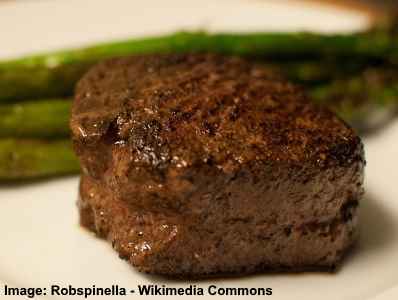
Type of steak: Filet Mignon (Tenderloin)
Filet mignon, or tenderloin, is one of the most tender cuts of beef that you can buy. This cut of steak comes from the middle of the cow on either side of the spine.
Because filet mignon is the leanest type of steak, it is the most desirable and the most expensive beef cut. The tenderloin is also one of the steaks with the lowest fat content.
A 100 g piece of filet mignon contains 217 calories, nearly 10 g of fat, and 30 g of protein. This serving of tenderloin contains 3 g of iron which is 17% of your recommended daily intake (RDI). There is also plenty of zinc, selenium, and phosphorus in tenderloin steak. (2)
Depending on the type of beef cut and the fat content, there may be more calories and fat. For example, a cut of 100 g tenderloin trimmed to 1/8" fat contains 324 calories and 24 g of fat. (3)
Due to the low-fat content of lean tenderloin, it has a mild taste and is not as tasty as some other types of steak.
Steak tartare is a type of raw steak enjoyed by some people. This is not a cut of beef but finely chopped tenderloin that is mixed with other ingredients. Steak tartare is usually served raw with a raw egg yolk.
Ribeye Steak
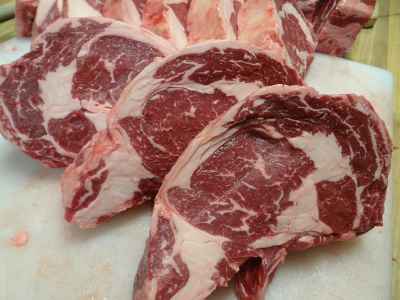
Type of steak: Ribeye
Ribeye (rib eye) beef cut is one of tastiest types of steak because it has fat marbling through the steak. Although not as tender as filet mignon, it ranks in the list of the top 10 tenderest steaks. (16)
The ribeye cut of beef comes from the rib area of the cow. The beef cut contains fat running through it, as well as some muscle tissue.
Ribeye steaks contain 303 calories for every 100 g of beef. This serving of steak also has 23.5 g of fat and 22 g of protein. So, a whole ribeye cut of steak (281 g) could have as much as 66 g of fat. (4)
Due to its high-fat content, ribeye steaks are one of the best types of steaks for grilling or frying. The meat doesn't dry out and stays quite tender even if it is slightly overcooked.
Sirloin Steak (Strip Steak)
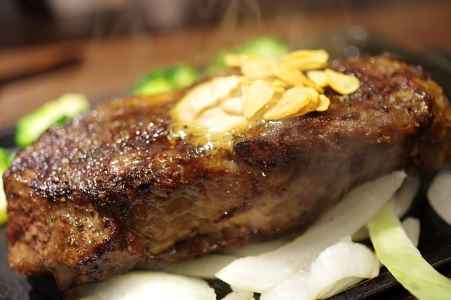
Type of steak: Sirloin
Strip steak, also called sirloin steak or contre-filet, is one of the most famous cuts of beef you can buy. This cut of beef is also referred to as New York Strip steak, Top Loin steak, or Kansas City steak.
Cuts of strip steak come from the upper middle area of the cow. Because this steak cut is from a part of the cow that does little work, it ranks among the top tender steaks. The light fat marbling through the cut gives the steak a delicious flavor.
The sirloin cut of beef also forms part of a type of steak called the T-bone. Depending on the cut used, there are top sirloin or bottom sirloin steaks.
Each 100 g portion of cooked sirloin steak contains 313 calories and 21 g of fat. As with all types of steak cuts, sirloin is a good source of vitamin B12, iron, zinc, and other nutrients. (5)
Because of the fat content, strip steaks (sirloin steaks) are easy to pan-fry, grill, or roast. They are very tender and tasty, which makes them one of the most popular types of steak.
Tri-Tip (Bottom Sirloin)
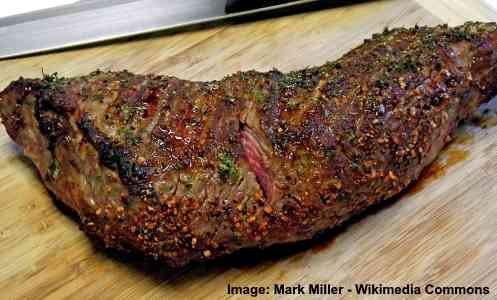
Type of steak: Tri-Tip
The tri-tip type of steak is a popular beef cut in the US and its name comes from the triangular shape of the steak.
Because the tri-tip steak is part of the sirloin, it is a relatively tender steak and is a healthier choice of steak due to its lower fat content.
For example, 100 g of bottom sirloin only contains 179 calories and 7 g of fat. However, this cut of beef is a higher source of protein than some other types of steak. (6)
T-Bone Steak
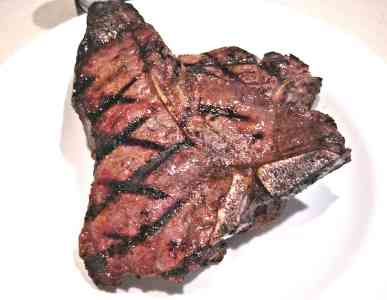
Type of steak: T-Bone
T-bone steak is one of the largest cuts of steak and is basically two types of steak in one – the tenderloin and strip (sirloin) steak.
Because the T-bone steak is a relatively large type of steak, it is also one of the most expensive steaks you can buy. The name of this steak comes from the T-shaped bone that separates the two cuts of meat.
The T-bone steak has relatively low levels of fat as it contains sirloin and tenderloin types of beef steak. A 100 g serving of T-bone contains 11 grams of fat. However, because this is always a large type of steak due to the bone size, a typical grilled T-bone will have just under 40 g of fat and 781 calories. (7)
Porterhouse is a type of T-bone steak. The difference between a T-bone and porterhouse steak is that the porterhouse includes more of the tenderloin.
Flank Steak
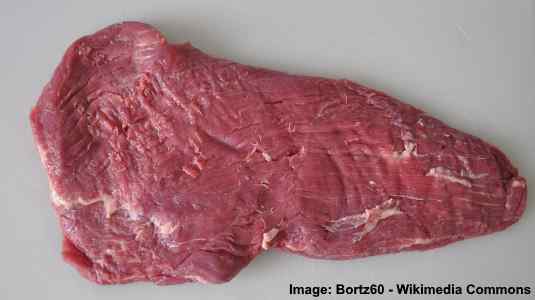
Type of steak: Flank steak
Compared to other types of steak, flank steak is a thin cut of beef and doesn't rank high on the list of tender beef cuts.
The flank steak comes from the abdominal region of the cow. Because it is closer to the leg muscles and gets a lot of use, there are more muscle fibers which makes it less tender than sirloin or ribeye.
The nutritional profile of flank steak shows that it is quite low in fat, with only 8 g fat per 100 g of beef. With 27 g of protein and 194 calories, flank steak is a relatively healthy choice of steak. (8)
The best way of serving flank steak is medium rare so that it doesn't become chewy or overcooked.
Skirt Steak

Type of steak: Skirt steak
Skirt steak is a type of long flat steak that is one of the tastiest steaks you can buy. Similar to the flank cut of beef, skirt steaks are not very tender.
Skirt steaks are cuts of meat from the underside of the front belly.
Compared to flank cuts of beef, skirt steaks have a higher fat content with 12 g of fat. As with all the different cuts of steak, skirt steak is an excellent source of dietary protein, iron, and some B-group vitamins. (9)
Due to their toughness, it is best to marinade skirt steaks before braising, grilling, or pan-frying them. Skirt steaks are also a delicious choice of beef if making fajitas or Chinese stir-fry.
Round (Topside)
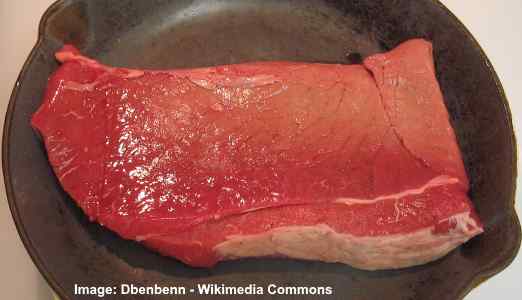
Type of steak: Round (Topside)
Topside is a tough cut of beef from the cow's upper back legs. This type of steak doesn't cook well when grilled or pan-fried. The best way to cook round steak is in a stew or braising it.
The nutritional value of this cut of steak shows that it is a healthy choice of beef. A 100 g portion of a lean cut of topside (round steak) only contains 7 g of fat and 182 calories. There are also good amounts of zinc, potassium, phosphorus, and iron in round steak. (10)
To cook round (topside) beef steak to make it tender, sear the cut of beef on both sides in a large pan. Remove the steak. Then, pour in about 2 cups of stock, add your favorite vegetables, and scrape the caramelized bits from the bottom of the pan. Return the topside steak to the pan and simmer covered for 60 minutes until the steak is tender.
Tomahawk
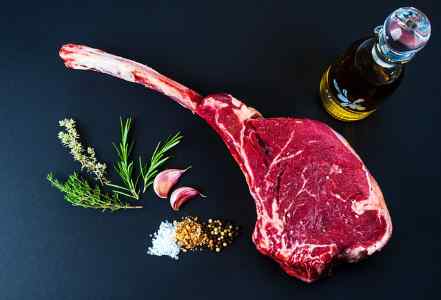
Type of steak: Tomahawk steak
Tomahawk steak gets its name from the way it looks – like a meat cleaver or tomahawk. The tender beef cut is actually just a ribeye steak with the bone attached.
The difference between tomahawk steaks and a ribeye cut is the thickness. Due to being served on the bone, tomahawk cuts of steaks can be around 5 cm thick. This means that one steak can sometimes weigh as much as 1 kg!
One of the best ways to cook a tomahawk steak is on the grill outdoors. The thick ribeye-type of steak is great to slice after it is cooked and then serve to your guests.
Chuck Eye Steak
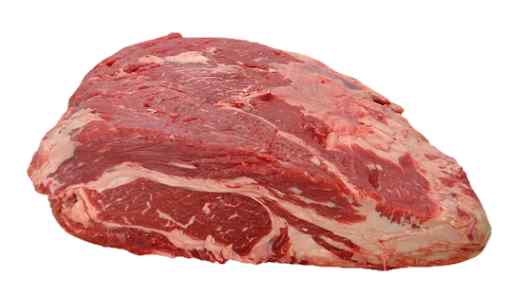
Type of steak: Chuck Eye steak
Chuck eye steaks are quite tender beef cuts and very similar to ribeye steak because they come from near the same part of a cow.
Chuck eye is a type of steak with a high-fat content (similar to rib eye), which makes it quite easy to cook. The beauty of using chuck eye cuts of beef is that they are cheaper than the ribeye but taste very similar.
Although a chuck eye is a cheap, tasty, and tender steak, it's not one of the healthiest. For example, there are 20 g of fat in every 100 g of beef steak. The calorie content of chuck eye steak is similar to a cut of ribeye steak having 277 calories per 100 g. (11)
It is good to remember not to confuse chuck eye steak with "chuck" steak. Types of steak described as "chuck" are usually tough, not very tender cuts of meat that need long, slow cooking to tenderize them.
How to Choose the Best Type of Steak
There are a few things to take into consideration when choosing the perfect cut of steak.
First, knowing the names of different types of steak helps to decide which cut of meat to buy. Some tender types of steak are tenderloin (and, the most expensive), ribeye steak, and strip steak.
To be sure of buying a very tender piece of steak, ensure that the steak has been hung for a period of time. Aging steak in this way for 10-14 days helps produce more tender cuts of steak with a better taste. (17)
Another factor to consider is how you plan to cook the steak. Prime cuts of beef such as T-bone steaks, sirloin, filet mignon, and ribeye steak are good for pan-frying or grilling. Less-tender types of steak such as skirt steak, flank steak, or round steak cook better when braised.
How to Cook the Perfect Steak
The best type of steak for grilling are the kinds with medium to high-fat content that come from the middle section of the cow.
Many consider sirloin steak and ribeye steak as the best kinds of steak for grilling or pan-frying. Tender cuts of beef are best served medium-rare and beef filet can be served rare to medium rare. In general, the longer you cook steak for, the less tender it becomes.
To cook the perfect steak, the cut of beef should be at room temperature and the pan or skillet should be very hot. Season your steak and cook on high heat for the required time to cook your steak rare, medium-rare, or medium. Steaks should be left to rest for 5-10 minutes before serving.
One concern about cooking meat at high temperatures is the fact that toxins and carcinogens can develop. Some studies suggest that meat cooked at high temperatures can increase the risk of certain cancers. (12)
Marinating steak is a way to prepare a steak for grilling or pan-frying that prevents toxins from forming. One study found that rosemary marinade may help to reduce the levels of harmful chemicals that develop during cooking. (13)
It is good to remember that steak can be a good source of important nutrients when consumed in moderation.
Steak can be bad for you if you eat too much red meat in your diet or choose fatty types of steak. There is also evidence to suggest that processed red meat (e.g. sausages) is worse for you than cuts of beef. (14)
Cuts of beef steak are not processed. Therefore, there is no evidence to suggest that eating a tasty lean steak once or twice a week increases your risk of heart disease. (15)
Is Steak Healthy?
One of the most commonly asked questions about steak is: is eating a steak good for you?
Steak is quite nutritious and can be healthy when consumed in moderation.
Red meat, including different types of beef steak, is an important source of protein and essential nutrients. Red type of meat provides you with iron, vitamin B12, and zinc. These are important nutrients that help keep nerve and red blood cells healthy. (1)
So, choosing healthy cuts of beef or lean steaks can be part of a healthy diet. In fact, scientists say that, as part of a balanced diet, moderate consumption of lean red meat doesn't increase your risk of cardiovascular diseases. (1)
Related articles:
- Common Types of Meat: Nutrition, Benefits and Concerns
Read Next
Source: https://leafyplace.com/types-of-steak/



0 Response to "Beef Soup Bone Steak Can You Eat as a Steak"
Post a Comment